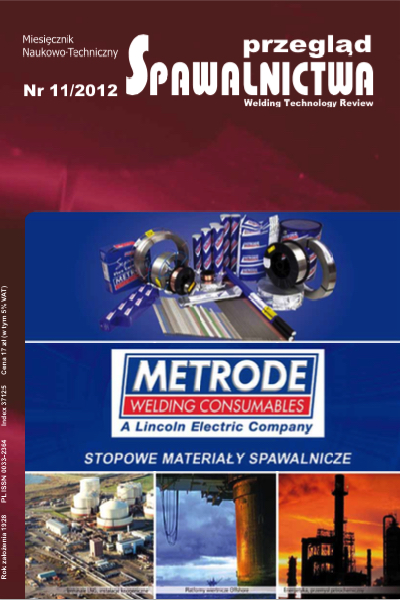Wpływ oparów metalicznych na spawanie łukowe - część 3: Modelowanie łuku spawalniczego dymy spawalnicze
Main Article Content
Abstract
W tej części artykułu przedstawiono wyniki oraz przewidywania obliczeniowego modelowania łuków spawalniczych, a także wpływ oparów metalicznych na parametry łuku. Omówiono powstawanie pyłów wpływających na zdrowie spawacza. Podsumowanie artykułu może być przydatne do tworzenia oprogramowania procesora źródła do sterowania stabilnością łuku, funkcjami ułatwiającymi spawanie i korekty błędów spawacza (reklamowanych w Australii jako oprogramowanie urządzeń, myślących za spawacza) [198].
The effects of metal vapour in arc welding, part 3: Modelling of welding arc results. welding fumes
The results and predictions of computational modeling of welding arcs and influence of metal vapour on arc parameters are presented in this part. The production of welding fume affecting the health of welder also is discussed. A summary of the article can be useful for developing software for intelligent processor control welding arc stability, weld assist functions and correction of errors welder advertised in Australia as a software welders who think for a welder [198].
Downloads
Article Details
Creative Commons CC BY 4.0 https://creativecommons.org/licenses/by/4.0/
Welding Technology Review (WTR) articles are published open access under a CC BY licence (Creative Commons Attribution 4.0 International licence). The CC BY licence is the most open licence available and considered the industry 'gold standard' for open access; it is also preferred by many funders. This licence allows readers to copy and redistribute the material in any medium or format, and to alter, transform, or build upon the material, including for commercial use, providing the original author is credited.
References
Tanaka M., Lowke J. J.: Predictions of weld pool profiles using plasma physics, J. Phys. D: Appl. Phys.40 R l-24 (2007).
Terasaki H., Tanaka m., Ushio m.: Effects of metal vapor on electron temperature in helium gas tungsten arcs, metall. mater. Trans. A 33 1183-8 (2002).
Zielińska S., musioł K., Dzierżęga K., Pellerin S., Valensi F., de Izarra C., Briand F.: Investigations of GmAW plasma by optical emission spectroscopy, Plasma Sources Sci. Tech- nol. 16 832-8 (2007).
Rouffet m. E., Wendt m., Goett G., Kozakov R., Schoepp H., Weltmann K. D., Uhrlandt D.: Spectroscopic investigation of the high-current phase of a pulsed GmAW.
Valensi F., Pellerin S., Boutaghane A., Dzierżęga K., Zielińska S., Pellerin n., Briand F.: Plasma diagnostic in gas metal arc welding by optical emission spectroscopy, J. Phys. D: Appl. Phys. 43 434002 (2010).
Zielińska S., Pellerin S., Valensi F., Dzierżęga K., Musioł K., de Izarra C., Briand F., Eur. Phys. J. Appl. Phys. 43 111-22 (2008).
Goecke S. F., metzke E., Spille-Kohoff A., Langula m.: ChopArc. mSG-Lichtbogenschweissen für den Ultraleichtbau, Stuttgart, Fraunhofer IRB Verlag (2005).
Gonzalez J. J., Bouaziz m., Razafinimanana m., Gleizes A.: The influence of iron vapour on an argon transferred arc,
Plasma Sources Sci. Technol. 6 20-8 (1997).
Farmer A. J. D., Haddad G. n., Cram L. E.: Temperature determinations in a free-burning arc: III. measurements with
molten anodes, J. Phys. D: Appl. Phys. 19 1723-30 (1986)
Smars E. A., Acinger K.: material transport and temperature distribution in arc between melting aluminium electrodes, Document no 212-162-68, International Institute of Welding (1968).
Schnick m., Füssel U., Hertel m., Haessler m., Spille-Kohoff A., murphy A. B.: modelling of gas-metal arc welding taking into account metal vapour, J. Phys. D: Appl. Phys. 43 434008 (2010).
Murphy A. B.: Thermal plasmas in gas mixtures, J. Phys. D:
Appl. Phys. 34 R151-73 (2001).
Gu L., Arntsberg A. E., Bakken J. A.: The influence of silicon vapour on the transport coefficients and the arc behaviour in an argon plasma, Proc. 10th Int. Symp. Plasma Chemistry ed, U. Ehlemann et al, paper 1.1-6, Bochum, Germany, 4-9 August 1991.
Gu L., Jensen R., Arntsberg A.E., Bakken J. A.: Study on silicon vapour contaminated argon arcs and the metal pools, Proc. 11th Int. Symp. Plasma Chemistry, (Loughborough, UK, 22-27 August 1993), ed. J.E. Harry s. 222-7(1993).
Bakken J. A.: modelling of fluid flow, heat transfer and diffusion in arcs, J. High Temp. Chem. Process. 3 677-88 (1994).
Murphy A .B., Boulos m. I., Colombo V., Fauchais P., Ghedini E., Gleizes A., mostaghimi J., Proulx P., Schram D. C.: Advanced thermal plasma modelling, High Temp. mater.
Process. 12 255-336 (2008).
Cram L. E.: Statistical evaluation of radiative power losses
from thermal plasmas due to spectral lines, J. Phys. D: Appl.
Phys. 18 401-11 (1985).
Iwao T., mori Y., Okubo m., Sakai T., Tashiro S., Tanaka m.,
Yumoto m.: modelling of metal vapor in pulse TIG including influence of self-absorption, J. Phys. D: Appl. Phys. 43 434010 (2010).
Tashiro S., Tanaka m., nakata K., Iwao T., Koshiishi F., Suzuki K., Yamazaki K.: Plasma properties of helium gas tungsten arc with metal vapour, Sci. Technol. Weld. Join. 12 202-7 (2007).
Schnick m., Füssel U., Hertel m., Spille-Kohoff A., murphy A. B.: metal vapour causes a central minimumin arc tempe- rature in gas-metal arc welding through increased radiative emission, J. Phys. D: Appl. Phys. 43 022001(2010).
Menart J., Lin L.: numerical study of a free burning argon arc with copper contamination from the anode, Plasma Chem. Plasma Process. 19 153-70 (1999).
Zhao G. Y., Dassanayabe m., Etemadi K.: numerical simulation of a free-burning argon arc with copper evaporation from the anode, Plasma Chem. Plasma Process. 10 87-99 (1990).
